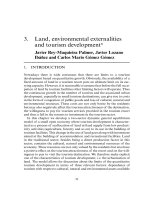THE ECONOMICS OF MONEY,BANKING, AND FINANCIAL MARKETS 487
Bạn đang xem bản rút gọn của tài liệu. Xem và tải ngay bản đầy đủ của tài liệu tại đây (57.84 KB, 1 trang )
CHAPTER 17
Tools of Monetary Policy
455
6000
5000
4000
3000
2000
1000
F I G U R E 17- 11
2009
2007
2005
2003
2001
1999
1997
1995
1993
1991
1989
1987
1985
1983
1981
1979
1977
1975
0
Bank of Canada Advances to Members of the Canadian Payments
Association, 1975 2008 (in millions of dollars)
Source: Statistics Canada CANSIM II Series V36663.
always been successful in preventing financial crises. Two examples of the use of
the Bank s lending weapon to avoid bank panics are the provisions of huge loans
to the Canadian Commercial Bank and the Northland Bank in 1985 (see the Inside
the Central Bank box, Emergency Lending Assistance to Troubled Banks).
Discretionary
Liquidity
Operations
Not only can the central bank be a lender of last resort to banks, but it can also play
the same role for the financial system as a whole. In fact, under the Bank of Canada
Act, under extreme conditions on a financial market or financial system, the Bank of
Canada has the authority to provide liquid funds to any (financial or nonfinancial)
Canadian or foreign entities, for the purpose of promoting the stability of the financial system. Such central bank intervention can help prevent financial panics that are
not triggered by bank failures, as was the case in the United States during the recent
financial crisis that started in August 2007 (see the Inside the Central Bank box,
Federal Reserve Lender-of-Last-Resort Facilities During the Subprime Financial Crisis).
Recently, central banks around the world have been facing significant challenges in implementing monetary policy because of the financial-market turmoil
and the subprime credit crisis in the United States. In response to these challenges,
central banks have been improving and refining their financial infrastructures to
address turmoil in the financial markets. Although there are differences across
countries in institutional arrangements for the conduct of monetary policy, most
central banks have responded to the recent financial turbulence in a similar fashion, providing liquidity directly to the financial system, called aggregate system or
macro liquidity.
To address market failure and financial instability at times of crisis, central
banks rely on discretionary liquidity operations, the maturity of which depends on
their objective, independent of the maturity of the reference rate. The Bank of
Canada, for example, recently introduced new facilities to address aggregate system liquidity at times of financial instability. In particular, the Bank introduced
term repos, known in Canada as term Purchase and Resale Agreements (PRAs),
and term securities lending.9
Let s see how these new facilities are used in providing liquidity to specific
markets as opposed to lending directly to banks.
9
For more details, see Walter Engert, Jack Selody, and Carolyn Wilkins, Financial Market Turmoil and
Central Bank Intervention, Financial System Review (June 2008), 71 78.









